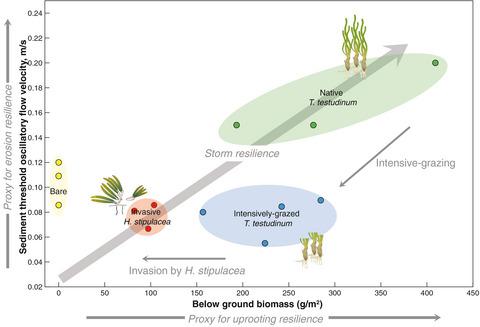Our official English website, www.x-mol.net, welcomes your feedback! (Note: you will need to create a separate account there.)
Seagrass coastal protection services reduced by invasive species expansion and megaherbivore grazing
Journal of Ecology ( IF 5.5 ) Pub Date : 2020-05-07 , DOI: 10.1111/1365-2745.13411 Rebecca K. James 1, 2 , Marjolijn J. A. Christianen 3 , Marieke M. Katwijk 4 , Jaco C. Smit 1 , Elisabeth S. Bakker 5, 6 , Peter M. J. Herman 7 , Tjeerd J. Bouma 1, 2, 8
中文翻译:

入侵物种的扩大和巨型食草动物的放牧减少了海草的沿海保护服务
更新日期:2020-05-07
Journal of Ecology ( IF 5.5 ) Pub Date : 2020-05-07 , DOI: 10.1111/1365-2745.13411 Rebecca K. James 1, 2 , Marjolijn J. A. Christianen 3 , Marieke M. Katwijk 4 , Jaco C. Smit 1 , Elisabeth S. Bakker 5, 6 , Peter M. J. Herman 7 , Tjeerd J. Bouma 1, 2, 8
Affiliation

|
- Seagrasses provide an important ecosystem service by creating a stable erosion‐resistant seabed that contributes to effective coastal protection. Variable morphologies and life‐history strategies, however, are likely to impact the sediment stabilization capacity of different seagrass species. We question how opportunistic invasive species and increasing grazing by megaherbivores may alter sediment stabilization services provided by established seagrass meadows, using the Caribbean as a case study.
- Utilizing two portable field‐flumes that simulate unidirectional and oscillatory flow regimes, we compared the sediment stabilization capacity of natural seagrass meadows in situ under current‐ and wave‐dominated regimes. Monospecific patches of a native (Thalassia testudinum) and an invasive (Halophila stipulacea) seagrass species were compared, along with the effect of three levels of megaherbivore grazing on T. testudinum: ungrazed, lightly grazed and intensively grazed.
- For both hydrodynamic regimes, the long‐leaved, dense meadows of the climax species, T. testudinum provided the highest stabilization. However, the loss of above‐ground biomass by intensive grazing reduced the capacity of the native seagrass to stabilize the surface sediment. Caribbean seagrass meadows are presently threatened by the rapid spread of the invasive opportunistic seagrass, H. stipulacea. The dense meadows of H. stipulacea were found to accumulate fine sediment, and thereby, appear to be effective in reducing bottom shear stress during calm periods. This fine sediment within the invasive meadows, however, is easily resuspended by hydrodynamic forces, and the low below‐ground biomass of H. stipulacea make it susceptible to uprooting during storm events, potentially leaving large regions vulnerable to erosion. Overall, this present study highlights that intensive megaherbivore grazing and opportunistic invasive species threaten the coastal protection services provided by mildly grazed native species.
- Synthesis. Seagrass meadows of dense, long‐leaved species stabilize the sediment surface and maintain the seabed integrity, thereby contributing to coastal protection. These services are threatened by intensive megaherbivore grazing, which reduces the stability of the surface sediment, and opportunistic invasive species, which are susceptible to uprooting in storms and thereby can leave the seabed vulnerable to erosion.
中文翻译:

入侵物种的扩大和巨型食草动物的放牧减少了海草的沿海保护服务
- 海草通过建立稳定的抗侵蚀海床为有效的海岸保护做出了重要的生态系统服务。然而,变化的形态和生活史策略可能会影响不同海草物种的沉积物稳定能力。我们以加勒比海地区为案例研究,质疑机会性入侵物种和巨型食草动物增加放牧会如何改变由既有海草草甸提供的沉积物稳定服务。
- 利用两个模拟单向和振荡流态的便携式野外水槽,我们比较了在电流和波浪主导下的天然海草草甸沉积物的稳定能力。本机(单特异性的补丁Thalassia testudinum)和侵入性(喜盐stipulacea)海草物种进行了比较,具有三个层次megaherbivore放牧的效果沿T. testudinum:ungrazed,轻轻擦过和集中擦过。
- 对于这两种流体动力机制,高潮物种长吻T的长叶茂密草地提供了最高的稳定性。但是,由于密集放牧而导致地上生物量的流失降低了天然海草稳定表层沉积物的能力。目前,加勒比海草草甸受到入侵的机会性海草(H. stipulacea)的迅速传播的威胁。发现叶草的茂密草地积聚了细小的沉积物,因此似乎可以有效地减少平静期的底部切应力。然而,侵入性草甸中的这种细小沉积物很容易被水动力和悬浮的低浓度的半球形链球菌再悬浮。使其在暴风雨期间容易连根拔起,有可能使大区域容易受到侵蚀。总体而言,本研究突出表明,大型食草动物的密集放牧和机会性入侵物种威胁着轻度放牧的本地物种提供的海岸保护服务。
- 综合。密集,长叶物种的海草草甸稳定了沉积物表面并保持了海床的完整性,从而为沿海保护做出了贡献。这些服务受到大型食草动物密集放牧的威胁,这降低了地表沉积物的稳定性,而机会性入侵物种则容易在暴风雨中连根拔起,从而使海底容易受到侵蚀。



























 京公网安备 11010802027423号
京公网安备 11010802027423号